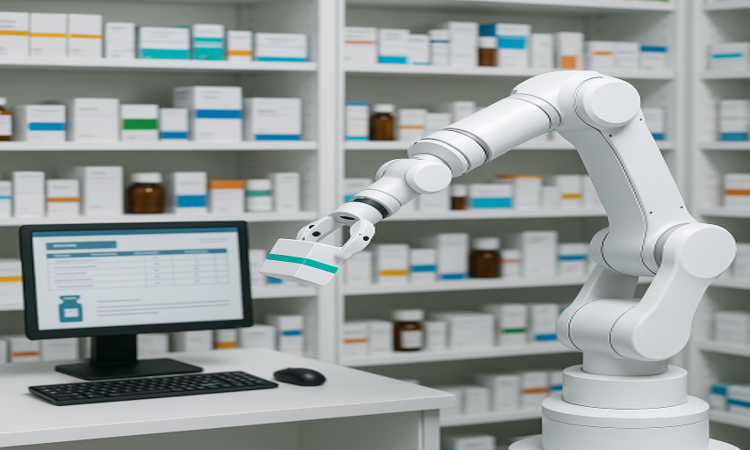The Rise of Robotics in Healthcare
Before getting into the specifics of robotics in pharmacy, it’s important to understand the broader trend of robotics in healthcare. Robotics has been used in a variety of medical fields, including surgery, rehabilitation, diagnostics, and hospital logistics. In pharmacy, however, its application has been particularly impactful due to the repetitive and accuracy-demanding nature of medication dispensing tasks. Automation in pharmacy began with simple pill counters and labelers. Over time, it has evolved into fully integrated robotic systems capable of handling complex tasks such as compounding medications, tracking inventory in real-time, and even interacting with patients through an AI-powered interface.
Applications of Robotics in Pharmacy
Automated Dispensing Systems
Automated dispensing robots are one of the most widespread applications of robotics in pharmacy. These machines can count, package, label, and dispense medications with incredible accuracy. Commonly used in both hospital and retail pharmacies, these systems reduce the risk of human error and speed up the medication fulfillment process.
Robotic Compounding of Medications
Robotic systems are increasingly being used in the compounding of intravenous (IV) medications, chemotherapy drugs, and other sterile preparations. These tasks require accuracy and strict adherence to a sterile environment, making robots ideal for this job.
Inventory management and restocking
Inventory management is a critical aspect of pharmacy operations. Robotic systems equipped with sensors and real-time tracking capabilities help monitor stock levels, expiration dates, and storage conditions.
Telepharmacy and remote dispensing
In rural or underserved areas, access to pharmacy services may be limited. Robotics combined with telepharmacy enables remote prescription verification and drug delivery, ensuring wider access to pharmaceutical care.
Robots in Clinical Trials and Research
Pharmaceutical research and development benefits from robotic automation in high-throughput screening, compound management, and formulation testing. These robots can perform repetitive tasks around the clock with minimal error, significantly speeding up drug discovery processes.
Benefits of Robotics in Pharmacy
Improved accuracy and patient safety
Medication errors can have serious consequences. Robotic systems are designed to follow precise instructions, reducing the likelihood of human mistakes such as dosing errors, incorrect labeling or drug interactions.
Increased efficiency and speed
Tasks that would take pharmacists hours to perform can be completed by robots in minutes. This efficiency not only speeds up service delivery, but also allows pharmacists to focus on more patient-focused activities such as consultations and clinical care.
Cost savings over time
While the initial investment in robotics can be significant, the long-term cost savings are substantial. Reduced labor costs, minimal drug waste and increased operational efficiency contribute to a strong return on investment.
Improved compliance and documentation
Robotic systems can maintain detailed logs of all activities, including who accessed which medication, when and why. This is invaluable for auditing purposes, regulatory compliance and quality assurance.
Workplace Safety
By reducing the need to handle hazardous medications and perform repetitive manual tasks, robotics helps create a safer work environment for pharmacy employees. It can also reduce workplace injuries and associated healthcare costs.
Challenges and Considerations
Despite the many benefits, adopting robotics in pharmacy is also fraught with challenges.
High initial investment
Robotic pharmacy systems can be costly to purchase, install, and maintain. Small pharmacies may have difficulty affording the initial expense, although scalable and modular solutions are becoming more accessible.
Integration with existing systems
Robotic systems need to integrate seamlessly with existing electronic health records (EHR), pharmacy management software, and inventory systems. Poor integration can lead to inefficiencies and errors.
Training and workforce optimization
Pharmacy staff must be trained to operate, maintain, and troubleshoot robotic systems. There is also the widespread concern of job displacement, although many experts argue that robotics will enhance rather than replace human roles.
Regulatory and ethical issues
Automated systems must adhere to strict regulatory guidelines, especially when handling controlled substances or sterile compounds. Ethical concerns may also arise over reliance on machines for critical healthcare functions.
Case Studies and Real-World Examples
UCSF Medical Center (San Francisco, USA)
UCSF has implemented a robotic pharmacy system that includes automated medication storage, retrieval, packaging, and dispensing. The result was a significant reduction in medication errors and improved workflow efficiency.
Hospital pharmacy in Germany
Many German hospitals use robotic systems for centralized mixing of IV medications. These robots can prepare hundreds of doses per day, ensuring consistent quality and reducing risk to pharmacists.
Remote dispensing units in Canada
In rural areas of Canada, robotic kiosks combined with telepharmacy services allow patients to obtain prescriptions without traveling long distances. This has been particularly impressive in First Nations communities and remote towns.
The Future of Robotics in Pharmacy
The future of pharmacy robotics is both promising and exciting. As artificial intelligence (AI) becomes more integrated with robotics, we can expect even more intelligent systems that are able to learn, adapt, and make autonomous decisions.
AI-driven decision making
Future robots could assist pharmacists in making clinical decisions by analyzing patient data, flagging potential drug interactions, and recommending alternative therapies.
Mobile robot assistants
Mobile robots capable of navigating hospital corridors are being developed to deliver medications directly to wards, reducing the need for human runners and improving delivery times.
Personalized medicine
With the rise of pharmacogenomics and personalized medicine, robotic systems could one day create customized drug treatments tailored to individual genetic profiles.
Sustainability and green pharmacy
Robotics could contribute to sustainability in pharmacies by reducing waste, optimizing energy use, and ensuring the proper disposal of expired or unused medications.
